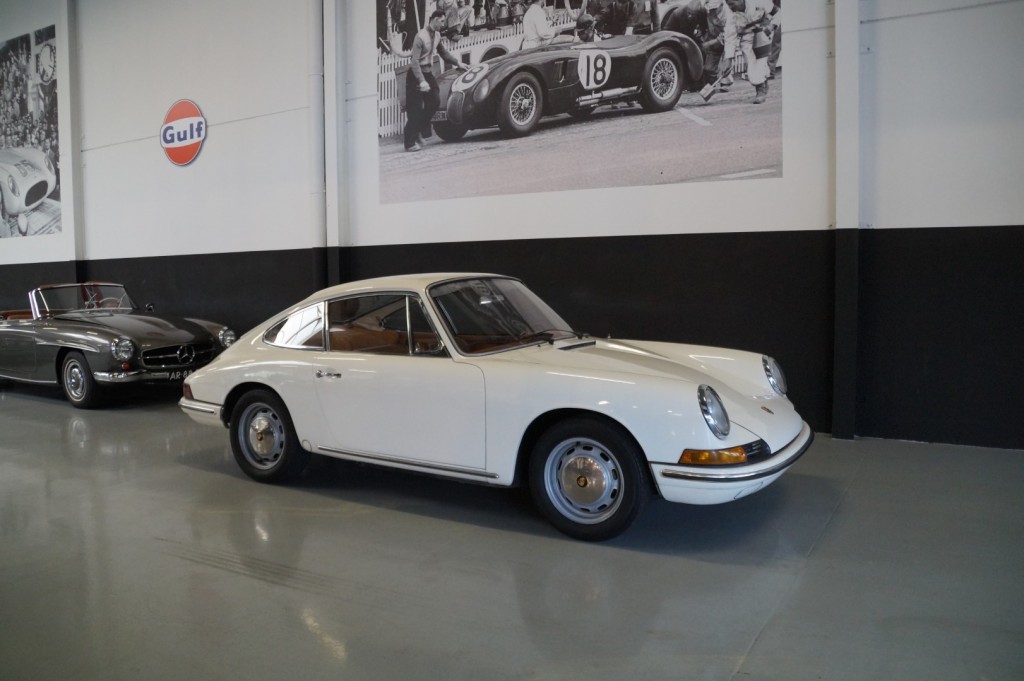
Sold  PORSCHE 912
PORSCHE 912
ABOUT THIS CLASSIC
Legendary Classics is proud to present this 1967 Porsche 912. The car was fairly recently imported by an enthusiast that came across the car after a long search. The car has an extensive service history that dates back to the earlier years when the car was still new. The car has been well maintained during its life and this shows on the car. The white paint is nice and has a nice luster.
The car was restored in the USA where the entire car was treated from the body to the mechanicals to the interior. The engine was also thoroughly checked by a Porsche specialist in Belgium.
The car has a restoration file where an extensive photo catalog was prepared.
In the early 1960s, Porsche was planning to discontinue the type 356 which would leave them with the newly-introduced Type 911 as their only product. Concerned that the considerable price increase of a 911 with flat opposed six-cylinder powerplant over the 356 would cost the company sales and narrow brand appeal, in 1963 Porsche executives decided to introduce a new four-cylinder entry-level model. Like the 911 (original internal factory designation "901"), the four-cylinder 912 was originally known at Zuffenhausen by a number with a zero in the middle, but the "902" designation was never used publicly. ("912" as project number was used after 1968 to indicate the 12 cylinder flat opposed engine developed for Porsche 917 racing car)
In 1963, Porsche assigned Dan Schwartz, later Chief Departmental Manager for Development, Mechanics, a project to oversee design and construction of a new horizontally-opposed four-cylinder engine for the 902, utilizing components from the new 901 six-cylinder engine, that would produce higher performance than their 356SC engine, and be less costly and complex than their Carrera 2 engine. Another option explored by Claus von Rücker was to increase displacement of the 356 Type 616 engine to 1.8-liters, add KugelFischer fuel injection, and modify both valve and cooling systems. Considering performance, cost, and scheduling, Porsche discontinued both of these design projects, and instead developed a third option, to tailor the 1.6-liter Type 616 engine to the 902.
Before 911 production commenced in 1964, the Porsche Vehicle Research Department had set aside chassis numbers 13328, 13329, 13330, 13352, and 13386 through 13397 for research testing of the 902; research vehicle Serial Number 13394 is the oldest 902 known to exist today. In production form, the Type 912 combined a 911 chassis / bodyshell with the 1.6L, four cylinder, push-rod Type 616/36 engine, based upon the Type 616/16 engine used in the Type 356SC of 1964-1965. With a lower compression ratio and new Solex carburetors, the Type 616/36 engine produced five less horsepower than the 616/16, but delivered about the same maximum torque at 3,500 rpm versus 4,200 rpm for the 616/16. Compared to the 911, the resulting production Type 912 vehicle demonstrated superior weight distribution, handling, and range. To bring 912 pricing close to the 356, Porsche also deleted some features standard on the 911. As production of the 356 concluded in 1965, on April 5, 1965 Porsche officially began production of the 912 coupe Styling, performance, quality construction, reliability, and price made the 912 a very attractive buy to both new and old customers, and it substantially outsold the 911 during the first few years of production. Porsche produced nearly 30,000 912 coupé units and about 2500 912 Targa body style units (Porsche's patented variation of a cabriolet) during a five-year manufacturing run.
The 912 was also made in a special version for the German autobahn police (Polizei); the 100,000th Porsche car was a 912 Targa for the police of Baden-Württemberg, the home state of Porsche. In the April 1967 edition, the Porsche factory's Christophorus Magazine noted: "On 21 December 1966, Porsche celebrated a particularly proud anniversary. The 100,000th Porsche, a 912 Targa outfitted for the police, was delivered." Porsche executives decided that after the 1969 model year, continuation of 912 production would not be viable, due to both internal and external factors. First, production facilities used for the 912 were reallocated to a new 914-6, a six-cylinder high performance version of the Porsche 914, Porsche-Volkswagen joint effort vehicle. Second, the 911 platform had returned to Porsche's traditional three performance-level ladder, including a most powerful 911S, a fuel-injected 911E, and a base model 911T, with pricing largely in line with market expectations. Third, more stringent United States engine emission control regulations also had a bearing on the decision; Ferry Porsche stated "It would have taken some trouble to prepare the 912 for the new exhaust rules, and with the arrival of the 914 we would have had three different engines to keep current. That was too many."
Call 0031623679846 for more information.
We ship to any location in the world. Ask our partner FreightHammer for a free shipping quote! (http://www.freighthammer.com/)
Wir sprechen Deutsch, We speak English, Nous parlons Français, Wij spreken Nederlands.
Appointments only
Monday - Friday: 10.00 - 17.00
Saturday: 10.00 - 14.00





